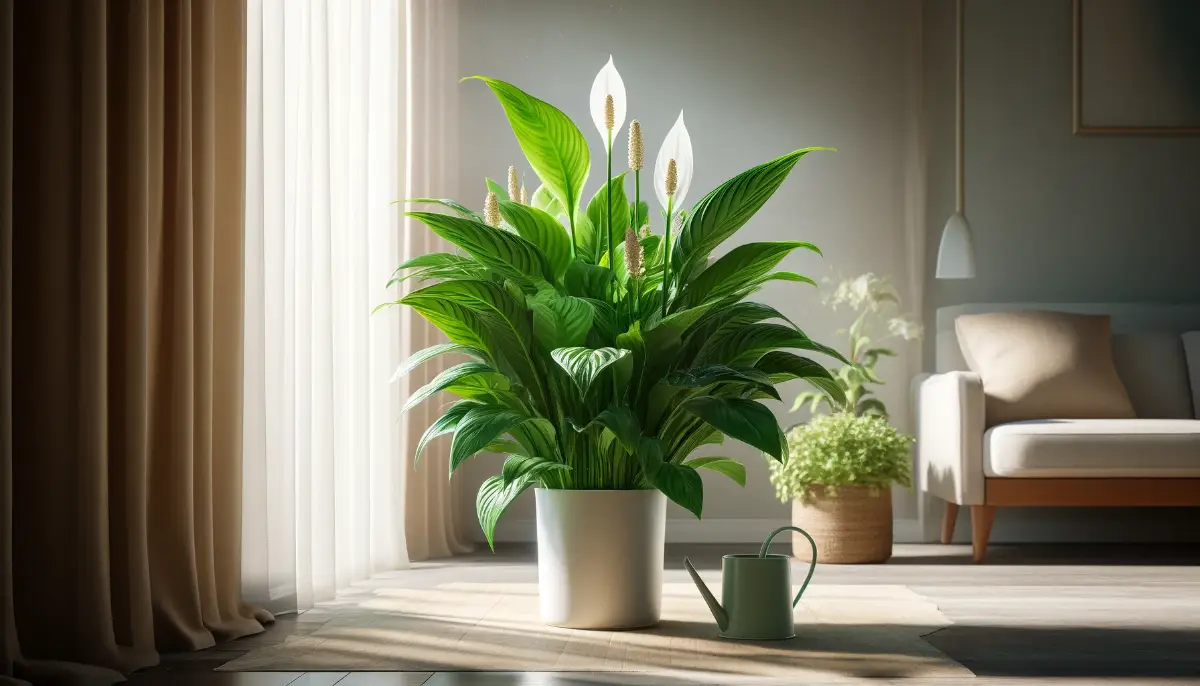Peace Lilies, scientifically known as Spathiphyllum, are cherished indoor plants renowned for their lush, glossy leaves and elegant white blooms.
These plants not only add a touch of tranquility and sophistication to any indoor setting but are also celebrated for their air-purifying qualities.
Known to filter out harmful toxins from the environment, Peace Lilies contribute to a cleaner and healthier living space, making them a popular choice for homes and offices alike.
Their low maintenance requirements and ability to thrive in low light conditions further enhance their appeal, allowing even novice gardeners to enjoy their beauty and benefits.
Basic Requirements for Growing Peace Lilies
Optimal Lighting
Optimal lighting is crucial for the health and beauty of Peace Lilies, and getting it right can significantly enhance their growth and flowering. Peace Lilies thrive in medium to bright indirect light, which mimics their natural rainforest habitat.
Direct sunlight, however, can be harmful and may cause the leaves to burn. It’s important to position them in a spot where sunlight is filtered through a curtain or placed a few feet away from a south or west-facing window.
While Peace Lilies are often touted for their ability to survive in low light conditions, this doesn’t mean no light. For optimal growth and to encourage blooming, they should receive bright, indirect light. If the plant isn’t producing flowers, it might be a sign that it needs a brighter location. Conversely, if the leaves are yellowing or the edges are getting burnt, it might be receiving too much direct light.
Managing the light exposure for Peace Lilies is about finding a balance where the plant receives just enough light without being exposed to harsh direct rays, ensuring healthy growth and flowering.
Watering Practices
Watering your Peace Lily correctly is key to ensuring its health and longevity. These plants prefer their soil to be consistently moist but not waterlogged. Here are some tips to achieve the ideal watering balance:
Watering Frequency and Amount: Peace Lilies should be watered thoroughly, allowing the water to seep through the drainage holes at the bottom of the pot. This ensures the roots are adequately hydrated.
The top inch of soil should be allowed to dry out before watering again. During the growing season (spring and summer), you might find yourself watering the plant every week, while in the cooler months, less frequent watering is necessary.
Read more about How to Water Indoor Plants
Signs of Need: A drooping Peace Lily is a clear indicator that it needs water. Pay attention to when the plant usually starts to sag, and plan to water it just before this happens to keep it perky and healthy.
Water Quality: Peace Lilies are sensitive to chemicals commonly found in tap water, such as chlorine and fluoride, which can cause brown leaf tips. To avoid this, use filtered, room-temperature water if possible.
Letting tap water sit overnight before using it can also help to dissipate chlorine.
Humidity Considerations: As tropical plants, Peace Lilies benefit from high humidity. Misting their leaves or placing their pot atop a tray of moistened gravel can help maintain the necessary humidity around them.
By monitoring the moisture level of the soil regularly and adjusting your watering schedule according to the temperature and humidity of your home, your Peace Lily will thrive.
Ideal Temperature and Humidity
Peace Lilies thrive in a warm, humid environment, reminiscent of their native tropical rainforest habitat. Here’s how to ensure the ideal temperature and humidity for your Peace Lily:
Temperature Preferences: Peace Lilies prefer average room temperatures between 60-80°F (15-27°C). They are sensitive to sudden temperature changes, so it’s crucial to keep them away from drafty windows and heating or cooling vents.
During the day, temperatures around 65-75°F (18-24°C) are optimal, with slightly cooler temperatures at night.
Maintaining Humidity: High humidity levels are beneficial for Peace Lilies, helping them maintain their lush appearance. You can increase humidity around your plant by:
- Misting the leaves regularly with lukewarm water.
- Placing the plant in naturally humid areas of your home, such as kitchens or bathrooms.
- Using a humidifier nearby or placing the plant on a tray filled with pebbles and water, ensuring that the bottom of the pot is not submerged.
These conditions not only support the plant’s growth but also enhance its ability to flower. It’s important to adjust care seasonally as indoor heating can reduce humidity during winter months, necessitating more frequent misting or other humidity-boosting methods.
Advanced Care Techniques
Soil and Fertilization
Choosing the right soil and fertilizer is essential for the health and growth of Peace Lilies. Here’s a detailed guide on how to select and use soil and organic fertilization for these plants:
Soil Requirements:
- Well-Draining Soil: Peace Lilies require well-draining soil that can retain some moisture without becoming waterlogged. A good mix for Peace Lilies includes a blend of peat moss, perlite, and vermiculite. This combination helps keep the soil light and airy, allowing roots to breathe and preventing issues such as root rot.
- pH Levels: They prefer slightly acidic to neutral soil, typically with a pH between 5.8 and 6.5. You can easily test your soil’s pH with a home testing kit available at garden centers.
Organic Fertilization:
- Fertilizing Frequency: During the growing season (spring and summer), fertilize Peace Lilies every 6 weeks with a balanced, water-soluble houseplant fertilizer diluted to half the recommended strength. It’s important to not over-fertilize as this can lead to salt buildup in the soil, which can harm the plant.
- Types of Organic Fertilizers: Organic options such as fish emulsion, seaweed extract, or compost tea are excellent choices. These provide nutrients slowly and safely, reducing the risk of over-fertilization and providing a wide range of nutrients that support overall plant health.
- Application Tips: Apply fertilizer to moist soil to avoid root burn and ensure even distribution of nutrients. Always follow the instructions on the fertilizer package for the best results.
Tips for How to Fix and Prevent Over-Fertilization
By ensuring your Peace Lily is planted in appropriate soil and using organic fertilizers wisely, you can maintain a healthy plant that grows vigorously and blooms beautifully.
Pruning and Maintenance
Pruning and regular maintenance are vital to keeping your Peace Lily healthy and looking its best. Here are some key practices to follow:
Pruning Needs:
- Removing Spent Blooms: Peace Lilies produce a flower-like structure called a spathe. Once these begin to fade and turn brown, they should be pruned to encourage new growth and maintain a tidy appearance. Use clean, sharp scissors to cut the spent bloom at the base of the flowering stem.
- Leaf Pruning: Remove any yellow or brown leaves by cutting them at the base near the soil. This not only improves the plant’s appearance but also redirects energy to healthier leaves and new growth.
General Maintenance Tips:
- Cleaning the Leaves: Peace Lily leaves can accumulate dust, which can inhibit photosynthesis and reduce the plant’s overall health. Wipe the leaves gently with a damp cloth or use a soft brush to keep them clean and efficient at processing sunlight.
- Soil and Root Health: Periodically check the soil and root system for signs of distress like a foul smell or overly soggy soil, which can indicate root rot. Refresh the soil as needed to ensure it remains nutrient-rich and well-draining.
Transplanting:
- Repotting: Peace Lilies typically need to be repotted every 18-24 months to prevent them from becoming root-bound. Choose a pot that is slightly larger than the current one and has good drainage. When repotting, gently tease the roots and trim away any that are dead or overly long before placing the plant in fresh potting mix.
By adhering to these pruning and maintenance guidelines, your Peace Lily will not only survive but thrive, providing a lush, green addition to your indoor spaces. These practices help ensure the plant’s energy is used efficiently, promoting growth and flowering.
Common Problems and Solutions
Peace Lilies are relatively low-maintenance plants, but they can encounter some common issues. Here’s how to identify and address these problems:
Yellow Leaves:
- Causes: Yellowing leaves can be a sign of overwatering, underwatering, or too much direct sunlight.
- Solution: Adjust your watering schedule to ensure the soil is moist but not soggy. Relocate your plant to a spot with indirect light if it is currently in a place that gets direct sunlight.
Brown Tips on Leaves:
- Causes: Often caused by dry air, low humidity, or fluoride in tap water.
- Solution: Increase humidity around the plant by misting the leaves or placing a humidifier nearby. Use filtered or distilled water to avoid fluoride damage.
Drooping:
- Causes: Drooping is typically a sign of either over or underwatering.
- Solution: Check the soil moisture. If it’s dry, water the plant thoroughly. If it’s overly damp, let it dry out before watering again. Ensure good drainage in the pot to prevent water from pooling at the base.
Pest Problems:
- Common Pests: Peace Lilies can be affected by spider mites, mealybugs, and aphids.
- Solution: Regularly inspect the leaves for pests and treat infestations with insecticidal soap or neem oil. Wiping leaves with a solution of 70% rubbing alcohol and 30% water can help remove mealybugs.
Root Rot:
- Causes: Caused by excessive watering which leads to a fungal growth in the soil.
- Solution: If you suspect root rot, you need to repot the plant into fresh soil and trim away any black, mushy roots. Improve drainage in the new potting mix, possibly adding more perlite or sand.
By understanding these common issues and knowing how to effectively respond, you can keep your Peace Lily healthy and thriving.
FAQs About Caring for Peace Lilies
Can Peace Lilies live outside?
Peace Lilies can be kept outdoors in warm, tropical climates (USDA zones 11+), but they should be brought indoors when temperatures drop below 65°F.
How often should Peace Lilies be watered?
Water when the top inch of soil feels dry. Typically, this will be about once a week, but adjust according to humidity and temperature conditions.
Do Peace Lilies need sunlight?
They thrive in bright, indirect light but can tolerate low light. However, insufficient light may prevent them from flowering.
Why are the leaves on my Peace Lily turning yellow?
Yellow leaves can be due to overwatering, underwatering, or too much direct sunlight. Adjust your care routine accordingly.
What is the best temperature for Peace Lilies?
They prefer temperatures between 65-75°F (18-24°C) during the day and slightly cooler at night. Avoid exposure to drafts and sudden temperature changes.
How can I increase humidity for my Peace Lily?
Misting the leaves, using a humidifier, or placing the plant on a tray of pebbles with water can help increase the humidity around the plant.
Why is my Peace Lily not flowering?
Lack of adequate light is a common reason. Ensuring that your Peace Lily gets enough indirect sunlight can help stimulate flowering.
How do I repot a Peace Lily?
Repot every 18-24 months in spring or early summer using well-draining soil and a slightly larger pot.
Are Peace Lilies toxic to pets?
Yes, they are toxic to cats and dogs if ingested, causing irritation of the mouth and stomach upset.
How do I treat root rot in Peace Lilies?
Remove the plant from its pot, trim away any black or mushy roots, and repot in fresh, well-draining soil. Adjust watering habits to prevent future occurrences









